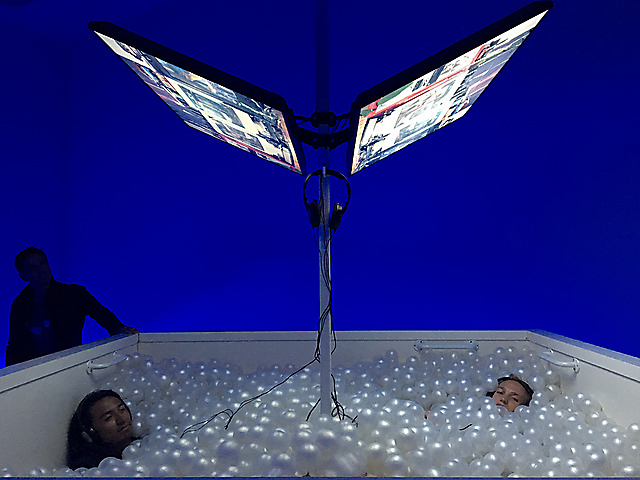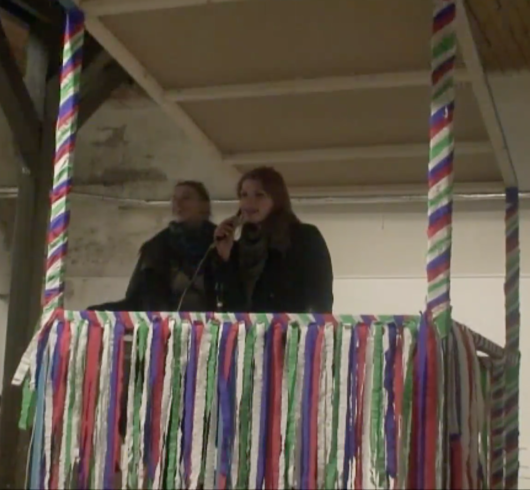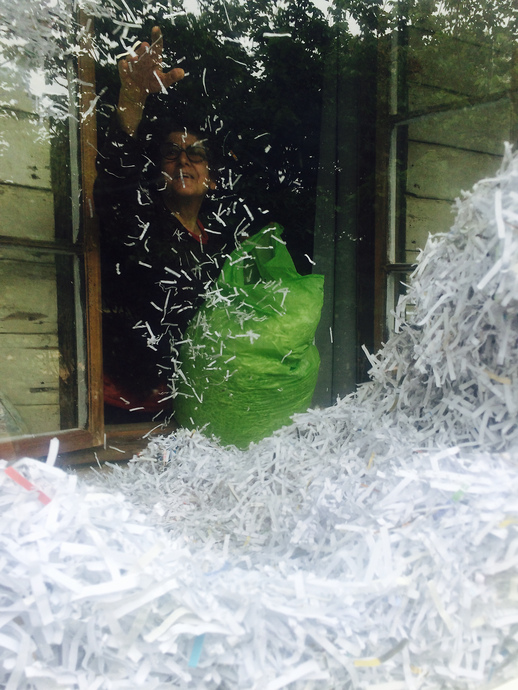Exhibition Intra-Actions: Experiences, Identities, and Texts in the Making
by Katve-Kaisa Kontturi, Helena Grande and Zuzana Štefková
In 2012, the philosopher Karen Barad was invited to participate in one of the most influential, recurring contemporary art events: the 13th Documenta in Kassel. Barad was by no means the only philosopher involved, there were 99 other philosophers and critical thinkers whose short essays were published in a series of 100 Notes – 100 thoughts. The colourful pocket-size series was published in the year preceding the event. The series, available both in print and online, did not so much discuss the works to be exhibited as showcase threads of contemporary thinking parallel to art. Later, the art journal Mousse published its Documenta (13) issue and Barad was again involved, this time via an interview entitled “Intra-actions”. Barad’s interview with the Documenta ‘agent’ Adam Kleinman (2012) has become an influential, oft-cited text, and we make extensive use of it in this exposition. What we want to stress with these opening lines is not simply that Barad’s thinking is crucial to the contemporary art scene, but also that her philosophy is crucially happening in relation to exhibition cultures today. Intra-actively, one might say.
In Ten Thousand Agencies of Observation, Helena Grande, inspired by her visit to Jon Rafman’s exhibition at the Stedelijk Museum in Amsterdam, 2016, studies how post-internet art happens intra-actively across the realms of the material and the discursive. This section begins by extending its scope beyond the exhibition space as it frames an analysis that centres on the history and practice of post-internet art, before returning to explore the experience of being physically ‘massaged’ by Rafman’s art.
"(...) phenomena are physical-conceptual (material-discursive) intra-actions whose unambiguous account requires a description of all relevant features of the experimental arrangement" Karen Barad 2007
"As Barad states in the introduction to Meeting the Universe Halfway: 'It is not so much that I have written this book, as that it has written me. Or rather, "we" have "intra-actively" written each other.' The same could be said about the process of curating."
Yet the logic of contemporary exhibition cultures is not necessarily intra-active in itself. For Barad (2012), intra-actions contest the causal logic that separates a phenomenon from its constitution: for example, there is no one (or more) individually constituted agent(s) behind a certain phenomenon. Rather, the relation between agents, objects, processes, and effects is far more complex. Agents themselves are reconfigured through the processes they engage; and phenomena are always, not only co-constituted, but agential. That said, contemporary exhibition cultures, for their part, often rely strongly on one key character or agent: the curator. And curatorial authority has come under some hefty criticism in recent times. In the polemical essay “Against Curating” (2017), for example, Stefan Heidenreich frames curating as an “undemocratic, authoritarian, opaque and corruptible” way of making exhibitions. Heidenreich claims that “without giving reasons, without discussion, curators choose their artists and decide where and how to show which kind of work”. “How is it that in the world of art where so much emphasis is placed on freedom,” Heidenreich asks “all the power is concentrated in the hands of exhibition autocrats?”.
In Curating Intra-Nationalities, Zuzana Štefková sheds light on how doing curatorial work for the exhibition Kassapoint (2010), which took place in the geopolitically ambivalent town of Košice, formerly of Great Hungary but now part of East Slovakia, contested nationality as a rigid, easily defined category. She focuses on a Karaoke machine as an intra-national apparatus in which nationalities are in the making through the act of singing Slovak national anthem, in a ‘wrong’ language.
With curatorial authority coming under scrutiny through intra-active approaches and other insights, the curator’s position within the dynamic framework of the exhibition is changing (see also Scatorro 2017; Oprea 2017). And it is changing in ways that are exciting, for these changes offer greater balance in the collaborative processes of the exhibition, with curators, artists, other contributors, supporters and exhibition attendees sharing responsibility for the experiences that exhibitions offer. In this exposition, encouraged by the intimate connections between Barad’s theory of intra-actions and contemporary art, and incited by the call ‘against curating’, we aim to study (some of) the complex material-discursive dynamics of art exhibitions beyond the sole authorship of a human. We do this through our own participatory experiences of being involved in art exhibitions in the roles of audience or viewer-participant, curator and artist-writer. Throughout the three sections, Barad’s conception of intra-action offers a way forward in understanding the complex processes that exhibitions are as phenomena. By studying a variety of ‘exhibition intra-actions’ in three different venues, we hope to attend to how the human and the nonhuman, the material and the discursive, the conceptual and the phenomenal entangle and intra-act in curatorial practices, attesting to the intricate complexity of the exhibition per se. This relational, non-binary processuality is key to comprehending how exhibitions are in the making across multiple intra-acting ‘levels’, by multiple co-constituted agencies.
In Writing with an emerging exhibition, Katve-Kaisa Kontturi invites the reader to engage with her experience of composing wall text for the 2016 group exhibition that celebrated small acts of ecology and the feminine in regional Victoria, Australia. Kontturi composed the text while staying, even sleeping, at the exhibition venue, when the exhibition was in the making. She discusses how she became part of the process of transforming the house into an exhibition; how she intimately, laboriously, yet responsibly collaborated with the curator, artists and art works, not only by writing, but by hanging, dusting and wiping.
"In this experiment, the writer intra-acted with … the works that came to the house, that became with the house. … She sees and documents the artists throwing shredded paper with the joyful pleasure of letting go. ... and finds unexpected treasures amongst the millions of pieces of shredded lectures: the 'doctors without'…"


